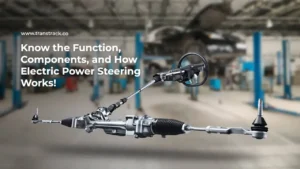Know the Types, How to Work, Benefits, Examples and Uses of Hour Meters!
Posted on June 6, 2024 by Nur Wachda Mihmidati

Hour meter is a tool or instrument used to measure and record the total operating time of a machine or equipment. This tool is often used on various types of industrial machinery, vehicles, and heavy equipment to monitor how long the machine has been operating. With this information, owners or operators can plan maintenance and care more effectively to prevent damage and ensure optimal performance. Check out other explanations through the following article TransTRACK!
Types of Hour Meters
This time measuring device is available in several types based on technology and how it works. The following is an explanation of the various types of this tool:
Mechanical Hour Meter
This type uses a gear mechanism to record the operating time of the machine. It is very durable and does not require electrical power. However, it lacks precision compared to the electronic type and has no additional features. Generally used on simple machines that do not require high accuracy.
Electronic Hour Meter
This type uses electronic components to record and display operating time. They are more precise and can display time in digital format. Often equipped with features such as maintenance alarms and data storage. Suitable for heavy equipment and modern industrial machinery.
Analog Hour Meter
This type uses a dial and needle to display the operating time. Although it works on electronic principles, the display is simple and easy to read. This type lacks additional features and may not be as precise as digital. Used in applications where simple visualization is sufficient.
Digital Hour Meter
This type displays operating time in digital number format, offering high precision. They are often equipped with features such as maintenance alarms and data storage. More expensive and require electrical or battery power. Ideal for modern industries that require accurate time recording.
Inductive Hour Meter
This type uses sensors to detect vibrations or electromagnetic fields from the engine. It does not require a direct electrical power source, only detects vibrations or electrical currents. Less precise than direct electronics, but practical for machines without easy access to electricity. Suitable for a wide range of operational conditions.
Wireless Hour Meter
This type uses wireless technology to transmit data to the receiving device. Allows for real-time and remote data collection and analysis. Requires additional setup and devices for wireless communication. Suitable for industrial environments that require efficient monitoring of operating time.
How Hour Meter Works
This time measuring device works by recording the operating time of a machine or device. The following is an explanation of how various types of hour meters work:
1. Mechanical Hour Meter
This type uses a system of gears and mechanical drives that are connected to the rotating part of the machine. As the engine operates, this rotation drives the gears inside the hour meter, which then turns a dial or number that records the operating time. As it does not require electricity, this type is very reliable in harsh and remote environments.
2. Electronic Hour Meter
This type works by using an electronic circuit that measures the time when a machine or device is turned on. It is usually connected to the machine’s power source or has sensors that detect machine operation. When the engine is started, the electronic circuitry starts recording the time and displays it in digital format or on an LCD screen.
3. Analog Hour Meter
This type of meter, although using electronic principles, displays the operating time through a needle and dial like a traditional clock. When the movement operates, the electronic circuitry inside the device sends a signal to move the hands on the dial, indicating the operating time. This type combines the convenience of analog readings with the reliability of electronics.
4. Digital Hour Meter
This type uses electronic technology to record and display the operating time in digital numeric format. When the engine is turned on, a sensor or electronic circuit starts counting the time and displays it in real-time on a digital screen. Many digital hour meters also come with additional features such as maintenance alarms and the ability to store operating data.
5. Inductive Hour Meter
This type uses an inductive sensor to detect vibrations or electromagnetic fields generated by operating machinery. This sensor sends a signal to the timekeeping unit every time a vibration or electromagnetic field is detected, recording the total operating time. This type is suitable for machines that do not have a direct electrical power source.
6. Wireless Hour Meter
Wireless hour meters record operating time and transmit this data wirelessly to a receiving device such as a smartphone or computer. It uses electronic sensors to detect machine operation and transmits the data via radio signal or Bluetooth. The received data can be analyzed and monitored in real-time, facilitating efficient machine management and maintenance.
Benefits of Hour Meters in Machine Maintenance
This time measurement tool has many benefits in machine maintenance, assisting owners and operators in maintaining the efficiency and longevity of equipment. Here are some of the key benefits:
1. Accurate Monitoring of Machine Operating Time
This timing device enables accurate monitoring of machine operating time, providing real-time data on the duration of operations. This information is essential for understanding machine workload and ensuring optimal usage. With the right data, operators can make better decisions about machine usage and maintenance.
2. Scheduling Preventive Maintenance Based on Operating Hours
By recording the operating hours of the machine, this time measuring device helps schedule preventive maintenance in a timely manner. Maintenance is scheduled based on specific time intervals, preventing major breakdowns. This ensures the machine gets maintenance before small problems develop.
3. Increased Machine Life and Reduced Downtime
This timing device contributes to increased machine life by ensuring regular maintenance is performed. Good maintenance reduces the chances of sudden breakdowns and downtime. This increases productivity and reduces emergency repair costs.
Examples of Hour Meter Use Cases in Various Industries
The following are examples of use cases of time measuring devices in various industries:
1. Agriculture
This tool is used on tractors and harvesting machines to monitor operating time. This helps farmers schedule regular maintenance and ensure the equipment is always in optimal condition. Well-maintained machinery increases efficiency during planting and harvesting seasons.
2. Construction
In construction, it is installed on heavy equipment such as bulldozers and excavators. This helps to organize maintenance schedules and prevent breakdowns that could hamper the project. Regular maintenance also extends the life of the machine and improves operational efficiency.
3. Manufacturing
In factories, it is used on production machines such as CNCs and compressors. Monitoring uptime allows managers to schedule preventive maintenance to prevent downtime. This helps in better production planning and resource management.
4. Transportation
In transportation, it is installed on buses and trucks to monitor engine operating hours. This helps determine appropriate maintenance schedules, ensuring vehicles operate safely and efficiently. Usage data also helps plan vehicle replacement based on actual usage.
How to Install and Use Hour Meters
Hour meters are an important tool for monitoring machine operating time and planning routine maintenance. The following are the steps to install and use this tool:
Preparation of Tools and Materials
- Prepare all necessary tools and materials, including hour meters, cables, connectors, screwdrivers, and installation manuals.
- Read the manual to understand the specifications and installation instructions recommended by the manufacturer.
Determining the Installation Location
- Choose a location that is easily accessible but does not interfere with machine operation.
- Ensure the location is protected from external elements that may damage the tool, such as water, dust, and excessive vibration.
Connecting the Hour Meter to the Power Source
- Connect the cables to the machine’s electrical power source according to the instruction manual. Usually, this involves connecting the positive and negative wires to the corresponding terminals on the machine.
- Make sure all connections are strong and not loose to prevent electrical problems.
Securing the Hour Meter
- Attach the tool to the selected place using the screws or other fasteners provided.
- Ensure that it is securely fastened and does not move or become dislodged during machine operation.
Activating the Hour Meter
- Once installed, it will start working when the engine is started.
- On electronic and digital types, the display will show the accumulated operating time.
Monitoring Operating Time
- Periodically, check the tool to monitor the number of operating hours recorded.
- Record the operating time for maintenance and machine management reference.
Scheduling Maintenance
- Based on the data from the tool, schedule routine maintenance according to the specified interval (for example, every 100 or 500 hours).
- Regular maintenance helps prevent breakdowns and ensures the machine operates at optimum efficiency.
Managing Data
- For digital and wireless hour meters, download and analyze run time data.
- Use this data for reporting, performance analysis and further maintenance planning.
By following this tutorial, you can install and use the tool correctly, aiding in efficient machine maintenance and extended machine life.
Hour Meter Usage and Reading Guide
Hour meters are an important tool for monitoring machine operating time and maintenance planning. The following is a step-by-step guide to using and reading this tool correctly:
1. Activating the Hour Meter
Ensure that it is properly installed on the machine and connected to an electrical power source or machine system. When the machine is turned on, it will start recording the operating time automatically.
2. Understanding the Hour Meter Display
They can have analog or digital displays, with hands or numbers indicating the number of hours of operation. Some digital hour meters come with controls to access additional features such as maintenance alarms or time settings.
3. Monitoring Operating Hours
Periodically, check the appliance to see the number of operating hours recorded, which indicates how long the machine has been in operation. Record the operating time for reference and further maintenance planning.
4. Establish a Maintenance Schedule
Based on the number of operating hours recorded, schedule regular maintenance according to the intervals recommended by the manufacturer or maintenance specialist. Schedule maintenance such as routine maintenance, parts replacement, and periodic inspections to prevent breakdowns and unexpected downtime.
5. Running Performance Analysis
Use data from this tool to analyze machine performance, including duration of operation and frequency of use. Identify machine usage patterns that can help in planning operational efficiency and cost savings.
With a deep understanding of the use and benefits of hour meters, you can improve efficiency and machine life in a timely manner. However, for more integrated and sophisticated management, TransTRACK offers a state-of-the-art Vehicle Maintenance System solution. With TransTRACK, you can easily track machine uptime, schedule preventive maintenance, and analyze your fleet’s overall performance. Don’t let unexpected downtime hamper your productivity. Switch to TransTRACK for better maintenance and smoother operations.
Recent Post
Know the Function, Components, and How Electric Power Steering Works!
December 24, 2025Know the Types of Buses Based on Their Model, Size, and Capacity!
December 22, 2025Topic :
Recommended Articles

 Bahasa Indonesia
Bahasa Indonesia








